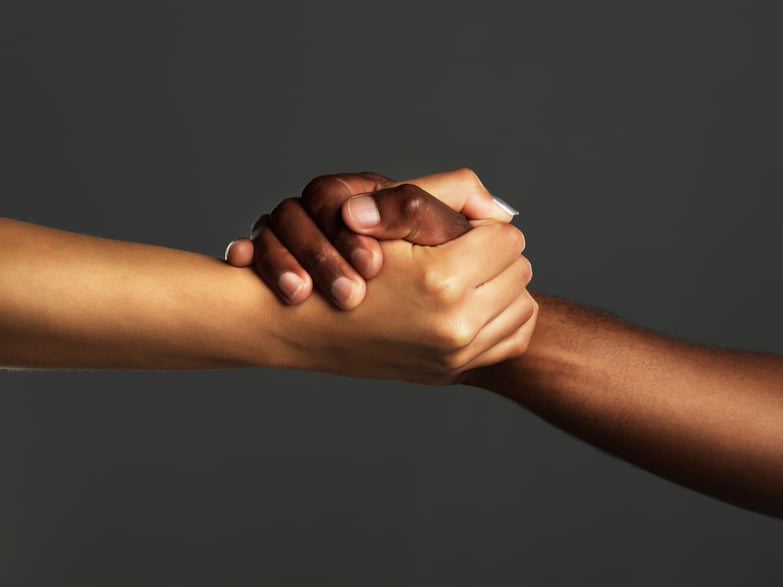
We ended last school year in a time of unraveling. On May 25th, 2020, George Floyd was murdered under the knee of Derek Chauvin while three other police officers stood by as accomplices. We as educators rose to support and hold space for our students to process and situate this moment in its larger movement, in defense of Black lives, and in the mourning of so many others. A reckoning took hold on the conscience of the nation, and James Baldwin’s words rang loud and clear: “History is literally present in all that we do.” We each were personally called to face our own positionality, our own biases, and our own complicity in sustaining systemic oppression—a call that is and will be ongoing.
To educators, we can learn from the complexity of this moment and gain insight into not only what divides, but what can bring us together in this collective project of building an antiracist society.
I am an educator of color, one who identifies as Asian American, and my attention was caught by another officer at the scene who stood by while Floyd died: Tou Thao. I, like many other Asian Americans, felt the uncomfortable pull of shared affinity towards and desire to distance from Thao, the Hmong American officer seen shielding Chauvin. Thao’s bystander behavior was called out, and rightly so, and I knew his Asianness played a critical role in how he was perceived. It felt easy to view him as an individual or, worse, as a model minority: passive and subordinate to Chauvin. And yet I knew there was something to be learned from inserting greater nuance into the conversation about anti-Asian sentiment and what it could teach us about racial injustice.
“Eradicating oppression,” as Charlene Carruthers writes, “requires us to identify connections, not sameness.” And it’s in this spirit that when exploring, for example, the model minority stereotype that’s imposed onto people of Asian descent, only so much is learned in isolation. We may envision an Asian doctor or engineer, or perhaps an Asian student pressured to excel in their studies. We may take pause at the inherent contradictions that exist, say, for Hmong people like Thao and other refugees displaced by the wreckage of the Vietnam War who faced xenophobia, segregation, and hate crimes when resettled in the U.S., and who still to this day disproportionately live in poverty. But this we mostly brush off as an exception to the “comfortable” notion that, here, anyone can succeed by their sturdy and steadfast efforts. In this isolation, we are both divided and seen as a monolith, and “Asian American” becomes, to Cathy Park Hong, “a racial group so nonspecific” that our intersectional identities are obscured without “any shared language between us.”
If we expand our gaze, we see more clearly the model minority as a tool of white supremacy, separating people of color and having at its core anti-Black racism. Certainly, implies the story, if one community of color can make it in America, why can’t you? This rose-colored narrative juxtaposes mostly those who emigrated from Asia after the passage of the 1965 Immigration and Nationality Act—many already having white-collar skills—with Black people experiencing urban blight and joblessness in the inner city while omitting the realities of racial terror lynching, redlining, and mass incarceration. We are forced into thinking in terms of the individual, rather than of the collective, and prevented from seeing the interconnectedness of, say, the 1882 Chinese Exclusion Act, passed with support from Southern Democrats in Congress bent on similar anti-Black aims in a post-slavery U.S., or the subsequent eugenics-backed immigration policies that codified racial quotas for decades. It hides from view the consequences of colonialism, the choiceless choice that so many made to find a better life across an ocean, and negates the lasting injury of slavery and the genocide of indigenous peoples stemming from long before the nation’s founding.
With clear echoes to today, we see the destruction of this narrative in the wake of the 1991 beating of Rodney King by white police officers in Los Angeles. Anti-Blackness in the Asian community had only increased tensions in the lead up to the riot, most notably with the shooting death of fifteen-year-old Latasha Harlins by Korean shop owner Soon Ja Du. In the ensuing aftermath of the officers’ acquittals the next year, the police were mostly absent, protecting white suburban communities. The media reported on the unrest one-dimensionally while Black, Latinx, and Korean businesses and homes burned, people killed.
W.E.B. Du Bois posed the question, “How does it feel to be a problem?” Generations later, Vijay Prashad asked people of Asian descent, “How does it feel to be the answer?” Taken together, we can realize greater connections to the workings of white supremacy in how it depends on the myth of meritocracy and individualism, dividing and degrading, and ultimately implicating us all within its oppressive reach, no matter our identities. When we are able to see these connections, we are able to see, as Bettina Love writes, our shared fate. Thao was a police officer—a role members of many immigrant groups throughout history take on—and he, Chauvin, and the other officers present were acting within this context. They murdered Floyd, and upstanders on the street courageously recorded and spoke out against what happened. Seeing the interconnectedness of all these individuals, and how they are webbed together in a history of power, oppression, and struggle for liberation, we can better understand just what we are combatting. Through this collective lens of history and of identity, we can be better positioned to stand up together.
As educators, we can consider: What can be gained by understanding the connections between perpetrators, victims, and bystanders? How well do I know my students, their identities and histories, our connectedness and our distinct yet shared fates? How does my curriculum, my school, and my community enable and prohibit antiracist practice? How can a sense of the collective, and of history, guide our choices?
Now, at the start of a new school year, we find ourselves amidst sad and familiar scenes playing out. Jacob Blake fights for his life as a result of police brutality, his children traumatized, a 17-year-old white teenager arrested for gunning down protesters with an assault rifle in downtown Kenosha. We cry, we rage, we demand, and we must stand up and lead and humanize.
John Lewis hoped historians would one day see that it was our “generation who laid down the heavy burdens of hate at last and that peace finally triumphed over violence, aggression and war.” It is our task as educators to seek connections, to think and act critically, and to embody this beloved community. As we start this year together, we can hold history—our shared, collective history—for ourselves and for our students, and have it be our guide.
--
Facing History and Ourselves invites educators to use our Teaching Current Events: Racial Justice in the United States resource collection in the classroom.


